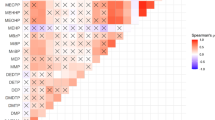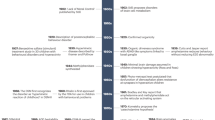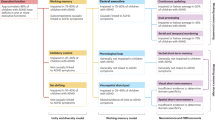Abstract
Pesticides are chemicals that are designed specifically for the purpose of killing or suppressing another living organism. Human toxicity is possible with any pesticide, and a growing body of literature has investigated possible associations with neurodevelopmental disorders. Attention deficit disorder with or without hyperactivity (ADHD) and autism spectrum disorder (ASD) are two of these specific disorders that have garnered particular interest. Exposure to toxic chemicals during critical windows of brain development is a biologically plausible mechanism. This review describes the basic laboratory science including controlled pesticide dosing experiments in animals that supports a mechanistic relationship in the development of ADHD and/or ASD. Epidemiological relationships are also described for low-level pesticide exposure and ADHD and/or ASD. The available evidence supports the hypothesis that pesticide exposure at levels that do not cause acute toxicity may be among the multifactorial causes of ADHD and ASD, though further study is needed, especially for some of the newer pesticides.
Similar content being viewed by others
Log in or create a free account to read this content
Gain free access to this article, as well as selected content from this journal and more on nature.com
or
References
Roberts, J. R. & Reigart, J. R. Recognition and Management of Pesticide Poisonings 1–272 (Office of Pesticide Programs U.S. Environmental Protection Agency, Washington, DC, 2013).
Rauh, V. A. & Margolis, A. E. Research review: environmental exposures, neurodevelopment, and child mental health - new paradigms for the study of brain and behavioral effects. J. Child Psychol. Psychiatry 57, 775–793 (2016).
Abreu-Villaca, Y. & Levin, E. D. Developmental neurotoxicity of succeeding generations of insecticides. Environ. Int. 99, 55–77 (2017).
Burke, R. D. et al. Developmental neurotoxicity of the organophosphorus insecticide chlorpyrifos: from clinical findings to preclinical models and potential mechanisms. J. Neurochem. 142(Suppl. 2), 162–177 (2017).
Sheets, L. P. et al. A critical review of neonicotinoid insecticides for developmental neurotoxicity. Crit. Rev. Toxicol. 46, 153–190 (2016).
Kalkbrenner, A. E., Schmidt, R. J. & Penlesky, A. C. Environmental chemical exposures and autism spectrum disorders: a review of the epidemiological evidence. Curr. Probl. Pediatr. Adolesc. Health Care 44, 277–318 (2014).
Landrigan, P. J. What causes autism? Exploring the environmental contribution. Curr. Opin. Pediatr. 22, 219–225 (2010).
America’s Children and the Environment (ACE). 3rd edn (2018). https://www.epa.gov/ace.
Rowland, A. S. et al. The prevalence of ADHD in a population-based sample. J. Atten. Disord. 19, 741–754 (2015).
Baio, J. et al. Prevalence of autism spectrum disorder among children aged 8 years—autism and developmental disabilities monitoring network, 11 sites, United States, 2014. MMWR. Surveill. Summ. 67, 1–23 (2018).
Liu, M. et al. From the cover: exposing imidacloprid interferes with neurogenesis through impacting on chick neural tube cell survival. Toxicol. Sci. 153, 137–148 (2016).
Makelarski, J. A. et al. Maternal periconceptional occupational pesticide exposure and neural tube defects. Birth Defects Res. A 100, 877–886 (2014).
Adams, J. et al. Workshop to identify critical windows of exposure for children’s health: neurobehavioral work group summary. Environ. Health Perspect. 108(Suppl. 3), 535–544 (2000).
Rice, D. & Barone, S. Jr. Critical periods of vulnerability for the developing nervous system: evidence from humans and animal models. Environ. Health Perspect. 108(Suppl. 3), 511–533 (2000).
Vester, A. & Caudle, W. M. The synapse as a central target for neurodevelopmental susceptibility to pesticides. Toxics 4, https://doi.org/10.3390/toxics4030018 (2016).
Folstein, S. E. & Rosen-Sheidley, B. Genetics of autism: complex aetiology for a heterogeneous disorder. Nat. Rev. Genet. 2, 943–955 (2001).
Taylor, M. J., Charman, T. & Ronald, A. Where are the strongest associations between autistic traits and traits of ADHD? Evidence from a community-based twin study. Eur. Child Adolesc. Psychiatry 24, 1129–1138 (2015).
Carter, C. J. & Blizard, R. A. Autism genes are selectively targeted by environmental pollutants including pesticides, heavy metals, bisphenol A, phthalates and many others in food, cosmetics or household products. Neurochem. Int. https://doi.org/10.1016/j.neuint.2016.10.011 (2016).
D’Amelio, M. et al. Paraoxonase gene variants are associated with autism in North America, but not in Italy: possible regional specificity in gene–environment interactions. Mol. Psychiatry 10, 1006–1016 (2005).
Canfield, R. L. et al. Intellectual impairment in children with blood lead concentrations below 10 microg per deciliter. N. Engl. J. Med. 348, 1517–1526 (2003).
Needleman, H. L. et al. Deficits in psychologic and classroom performance of children with elevated dentine lead levels. N. Engl. J. Med. 300, 689–695 (1979).
Lanphear, B. P. et al. Low-level environmental lead exposure and children’s intellectual function: an international pooled analysis. Environ. Health Perspect. 113, 894–899 (2005).
Schwartz, J. Low-level lead exposure and children’s IQ: a meta-analysis and search for a threshold. Environ. Res. 65, 42–55 (1994).
Harada, M. Minamata disease: methylmercury poisoning in Japan caused by environmental pollution. Crit. Rev. Toxicol. 25, 1–24 (1995).
Grandjean, P. & Perez, M. Developmental neurotoxicity: implications of methylmercury research. Int J. Environ. Health 2, 417–428 (2008).
Jacobson, J. L. J. S. & Humphrey, H. E. B. Effect on in utero exposure to polychlorinated biphenyls and related contaminants of cognitive functioning in young children. J. Pediatr. 116, 38–45 (1990).
Jacobson, J. L. & Jacobson, S. W. Intellectual impairment in children exposed to polychlorinated biphenyls in utero. N. Engl. J. Med. 335, 783–789 (1996).
Bouchard, M. F. et al. Prenatal exposure to organophosphate pesticides and IQ in 7-year-old children. Environ. Health Perspect. 119, 1189–1195 (2011).
Rauh, V. et al. Seven-year neurodevelopmental scores and prenatal exposure to chlorpyrifos, a common agricultural pesticide. Environ. Health Perspect. 119, 1196–1201 (2011).
Rauh, V. A. et al. Impact of prenatal chlorpyrifos exposure on neurodevelopment in the first 3 years of life among inner-city children. Pediatrics 118, e1845–e1859 (2006).
Engel, S. M. et al. Prenatal exposure to organophosphates, paraoxonase 1, and cognitive development in childhood. Environ. Health Perspect. 119, 1182–1188 (2011).
Eskenazi, B. et al. Pesticide toxicity and the developing brain. Basic Clin. Pharmacol. Toxicol. 102, 228–236 (2008).
Engel, S. M. et al. Prenatal organophosphate metabolite and organochlorine levels and performance on the Brazelton Neonatal Behavioral Assessment Scale in a multiethnic pregnancy cohort. Am. J. Epidemiol. 165, 1397–1404 (2007).
Kim, I. S. & Dickinson, M. H. Idiothetic path integration in the fruit fly Drosophila melanogaster. Curr. Biol. 27, 2227–38e3 (2017).
Richendrfer, H., Pelkowski, S. D., Colwill, R. M. & Creton, R. Developmental sub-chronic exposure to chlorpyrifos reduces anxiety-related behavior in zebrafish larvae. Neurotoxicol. Teratol. 34, 458–465 (2012).
Lee, I., Eriksson, P., Fredriksson, A., Buratovic, S. & Viberg, H. Developmental neurotoxic effects of two pesticides: Behavior and biomolecular studies on chlorpyrifos and carbaryl. Toxicol. Appl. Pharmacol. 288, 429–438 (2015).
Richardson, J. R. et al. Developmental pesticide exposure reproduces features of attention deficit hyperactivity disorder. FASEB J. 29, 1960–1972 (2015).
Grabovska, S. & Salyha, Y. ADHD-like behaviour in the offspring of female rats exposed to low chlorpyrifos doses before pregnancy. Arh. Hig. Rada Toksikol. 66, 121–127 (2015).
Shelton, J. F., Hertz-Picciotto, I. & Pessah, I. N. Tipping the balance of autism risk: potential mechanisms linking pesticides and autism. Environ. Health Perspect. 120, 944–951 (2012).
Kim, S., Lee, H. S. & Park, Y. Perinatal exposure to low-dose imidacloprid causes ADHD-like symptoms: Evidences from an invertebrate model study. Food Chem. Toxicol. 110, 402–407 (2017).
Tomizawa, M. & Casida, J. E. Neonicotinoid insecticide toxicology: mechanisms of selective action. Annu. Rev. Pharmacol. Toxicol. 45, 247–268 (2005).
Kimura-Kuroda, J., Komuta, Y., Kuroda, Y., Hayashi, M. & Kawano, H. Nicotine-like effects of the neonicotinoid insecticides acetamiprid and imidacloprid on cerebellar neurons from neonatal rats. PLoS ONE 7, e32432 (2012).
Li, P., Ann, J. & Akk, G. Activation and modulation of human alpha4beta2 nicotinic acetylcholine receptors by the neonicotinoids clothianidin and imidacloprid. J. Neurosci. Res. 89, 1295–1301 (2011).
Bouchard, M. F., Bellinger, D. C., Wright, R. O. & Weisskopf, M. G. Attention-deficit/hyperactivity disorder and urinary metabolites of organophosphate pesticides. Pediatrics 125, e1270–e1277 (2010).
Quiros-Alcala, L., Mehta, S. & Eskenazi, B. Pyrethroid pesticide exposure and parental report of learning disability and attention deficit/hyperactivity disorder in U.S. children: NHANES 1999–2002. Environ. Health Perspect. 122, 1336–1342 (2014).
Wagner-Schuman, M. et al. Association of pyrethroid pesticide exposure with attention-deficit/hyperactivity disorder in a nationally representative sample of U.S. children. Environ. Health 14, 44 (2015).
van Wendel de Joode, B. et al. Pesticide exposure and neurodevelopment in children aged 6-9 years from Talamanca, Costa Rica. Cortex 85, 137–150 (2016).
Yu, C. J. et al. Increased risk of attention-deficit/hyperactivity disorder associated with exposure to organophosphate pesticide in Taiwanese children. Andrology 4, 695–705 (2016).
Saez, M., Barcelo, M. A., Farrerons, M. & Lopez-Casasnovas, G. The association between exposure to environmental factors and the occurrence of attention-deficit/hyperactivity disorder (ADHD). A population-based retrospective cohort study. Environ. Res. 166, 205–214 (2018).
Marks, A. R. et al. Organophosphate pesticide exposure and attention in young Mexican-American children: the CHAMACOS study. Environ. Health Perspect. 118, 1768–1774 (2010).
Rauh, V. A. et al. Prenatal exposure to the organophosphate pesticide chlorpyrifos and childhood tremor. Neurotoxicology 51, 80–86 (2015).
Ribas-Fito, N. et al. Exposure to hexachlorobenzene during pregnancy and children’s social behavior at 4 years of age. Environ. Health Perspect. 115, 447–450 (2007).
Sagiv, S. K. et al. Prenatal organochlorine exposure and behaviors associated with attention deficit hyperactivity disorder in school-aged children. Am. J. Epidemiol. 171, 593–601 (2010).
Sioen, I. et al. Prenatal exposure to environmental contaminants and behavioural problems at age 7–8 years. Environ. Int. 59, 225–231 (2013).
Schmidt, R. J. et al. Self-reported pregnancy exposures and placental DNA methylation in the MARBLES prospective autism sibling study. Environ. Epigenet. 2, https://doi.org/10.1093/eep/dvw024 (2016).
Pearson, B. L. et al. Identification of chemicals that mimic transcriptional changes associated with autism, brain aging and neurodegeneration. Nat. Commun. 7, 11173 (2016).
Schwartzer, J. J., Koenig, C. M. & Berman, R. F. Using mouse models of autism spectrum disorders to study the neurotoxicology of gene–environment interactions. Neurotoxicol. Teratol. 36, 17–35 (2013).
McFarlane, H. G. et al. Autism-like behavioral phenotypes in BTBR T+tf/J mice. Genes Brain. Behav. 7, 152–163 (2008).
De Felice, A., Scattoni, M. L., Ricceri, L. & Calamandrei, G. Prenatal exposure to a common organophosphate insecticide delays motor development in a mouse model of idiopathic autism. PLoS ONE 10, e0121663 (2015).
Mullen, B. R., Khialeeva, E., Hoffman, D. B., Ghiani, C. A. & Carpenter, E. M. Decreased reelin expression and organophosphate pesticide exposure alters mouse behaviour and brain morphology. ASN Neuro 5, e00106 (2012).
Mullen, B. R. et al. A complex interaction between reduced reelin expression and prenatal organophosphate exposure alters neuronal cell morphology. ASN Neuro 8, https://doi.org/10.1177/1759091416656253 (2016).
Folsom, T. D. & Fatemi, S. H. The involvement of Reelin in neurodevelopmental disorders. Neuropharmacology 68, 122–135 (2013).
Lan, A., Kalimian, M., Amram, B. & Kofman, O. Prenatal chlorpyrifos leads to autism-like deficits in C57Bl6/J mice. Environ. Health 16, 43 (2017).
Roberts, E. M. et al. Maternal residence near agricultural pesticide applications and autism spectrum disorders among children in the California Central Valley. Environ. Health Perspect. 115, 1482–1489 (2007).
Shelton, J. F. et al. Neurodevelopmental disorders and prenatal residential proximity to agricultural pesticides: the CHARGE study. Environ. Health Perspect. 122, 1103–1109 (2014).
Keil, A. P., Daniels, J. L. & Hertz-Picciotto, I. Autism spectrum disorder, flea and tick medication, and adjustments for exposure misclassification: the CHARGE (CHildhood Autism Risks from Genetics and Environment) case–control study. Environ. Health 13, 3 (2014).
Schmidt, R. J. et al. Combined prenatal pesticide exposure and folic acid intake in relation to autism spectrum disorder. Environ. Health Perspect. 125, 097007 (2017).
Lyall, K. et al. Polychlorinated biphenyl and organochlorine pesticide concentrations in maternal mid-pregnancy serum samples: association with autism spectrum disorder and intellectual disability. Environ. Health Perspect. 125, 474–480 (2017).
Brown, A. S. et al. Association of maternal insecticide levels with autism in offspring from a national birth cohort. Am. J. Psychiatry https://doi.org/10.1176/appi.ajp.2018.17101129 (2018).
Braun, J. M. et al. Gestational exposure to endocrine-disrupting chemicals and reciprocal social, repetitive, and stereotypic behaviors in 4- and 5-year-old children: the HOME study. Environ. Health Perspect. 122, 513–520 (2014).
Furlong, M. A., Engel, S. M., Barr, D. B. & Wolff, M. S. Prenatal exposure to organophosphate pesticides and reciprocal social behavior in childhood. Environ. Int. 70, 125–131 (2014).
Eskenazi, B. et al. Organophosphate pesticide exposure and neurodevelopment in young Mexican-American children. Environ. Health Perspect. 115, 792–798 (2007).
Sagiv, S. K. et al. Prenatal organophosphate pesticide exposure and traits related to autism spectrum disorders in a population living in proximity to agriculture. Environ. Health Perspect. 126, 047012 (2018).
Philippat, C. et al. Prenatal exposure to organophosphate pesticides and risk of autism spectrum disorders and other non-typical development at 3 years in a high-risk cohort. Int. J. Hyg. Environ. Health 221, 548–555 (2018).
Author information
Authors and Affiliations
Corresponding author
Ethics declarations
Competing interests
The authors declare no competing interests.
Additional information
Publisher's note: Springer Nature remains neutral with regard to jurisdictional claims in published maps and institutional affiliations.
Rights and permissions
About this article
Cite this article
Roberts, J.R., Dawley, E.H. & Reigart, J.R. Children’s low-level pesticide exposure and associations with autism and ADHD: a review. Pediatr Res 85, 234–241 (2019). https://doi.org/10.1038/s41390-018-0200-z
Received:
Revised:
Accepted:
Published:
Issue date:
DOI: https://doi.org/10.1038/s41390-018-0200-z
This article is cited by
-
Association between some environmental risk factors and attention-deficit hyperactivity disorder among children in Egypt: a case-control study
Italian Journal of Pediatrics (2025)
-
Recent advances and current challenges of new approach methodologies in developmental and adult neurotoxicity testing
Archives of Toxicology (2024)
-
Assessment of Preschool Children’s Exposure Levels to Organophosphate and Pyrethroid Pesticide: A Human Biomonitoring Study in Two Turkish Provinces
Archives of Environmental Contamination and Toxicology (2023)
-
Perinatal exposure to pesticides alters synaptic plasticity signaling and induces behavioral deficits associated with neurodevelopmental disorders
Cell Biology and Toxicology (2023)
-
Ca2+ imaging with two-photon microscopy to detect the disruption of brain function in mice administered neonicotinoid insecticides
Scientific Reports (2022)



